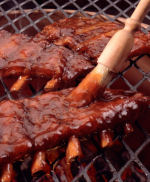Useful Tips for Cooking
over the Grill or Smoker
Welcome to this section to offer various tips for outdoor cooking. These tips are proven and will increase your effectiveness over the hot coals which we love to toil! Read on and now you are improving with each time you cook outdoors!
Enjoy!

| While each tip can mostly stand alone, it is best to read them all and incorporate them into an overall assault on the grill. Be sure to have your assault well fortified with your favorite beverage! Today's tip is:
Glazing Your Meat
|

 At the end of the day, after the yard work has been completed, it's time to relax over the grill preparing some really fine barbecue. Often, preparing the best barbecue means obtaining the absolute best, freshest cuts of meat possible. It can be hamburgers not steaks, or chicken not lobster. Many times it is the techniques that make even a less desirable piece of meat into a tender, delicious morsel. At the end of the day, after the yard work has been completed, it's time to relax over the grill preparing some really fine barbecue. Often, preparing the best barbecue means obtaining the absolute best, freshest cuts of meat possible. It can be hamburgers not steaks, or chicken not lobster. Many times it is the techniques that make even a less desirable piece of meat into a tender, delicious morsel.
Today, we wanted to talk about how to get the most out of your meat, grill and outdoor cooking experience through glazing your meat.
Before we get into the details, glazing IS NOT basting, but is done using a sweet barbecue sauce to produce a beautiful glaze prior to serving. That having been said, let's continue...
 |
Using a pastry brush and over low heat, glaze all sides of your meat 30 minutes before serving.
Click For Larger Image |
 If you are a serious competition cook or barbecue'n perfectionist who loves the presentation of your efforts, then you know all about glazing you meats prior to serving. Glazing is a lot about show and a little about flavor. Glazing the meat is an extra step in the process that occurs between the cooker and the plate. If you are a serious competition cook or barbecue'n perfectionist who loves the presentation of your efforts, then you know all about glazing you meats prior to serving. Glazing is a lot about show and a little about flavor. Glazing the meat is an extra step in the process that occurs between the cooker and the plate.
When we glaze our meats, we use a pastry brush (usually) or other bbq brush and apply a thin coat of barbecue sauce to all surfaces of the meat. The barbecue sauce we use usually consists of a high concentration of sugars/corn syrups.
Many folks, maybe even most, do not glaze the meat as it requires more ingredients and time. Keep in mind that we ARE NOT talking about drowning the meat in sauce like you might find at a restaurant.
What we ARE talking about is applying a thin layer of sweet sauce on the surface of the meat and allowing it to "set" or become tacky to the touch. Glazing the meat is usually performed once the pit/grill has subsided from its high temperatures and you are about 30 minutes away from serving. If you glaze too soon, then you risk the possibility of burning, caramelizing or blackening the glaze (because of the sugars/tomatoes in the sauce and the high heat) which you will find detrimental to your efforts. Once the glaze has a dull shine and/or tackiness to the surface then you are ready to serve.
What to glaze? You would probably choose to glaze most anything that is barbecued (cooked low and slow over moderate temperatures) such as pork ribs, chicken, ham, brisket, pork butt and tenderloins (when barbecued).
A glaze will do several things for you:
- Make the appearance of the meat shiny.
- Add some flavor to the outside of the meat.
- Add a thickness to the outside of the meat ... often called the "Bark".
When not to Glaze:
- You would not want to glaze steaks, chops or pulled pork, or Veggies.
- Any other meat which you are grilling directly over high heat.
Glazing should be limited to one coating per surface. Don't try more as it will become a gooey mess and not set up properly. Again, glazing is a lot about show and a little about flavor. Judges have come to expect it as one of the categories is appearance while family and friends will certainly take note of your "job well done!".
Making your own? Try such sauces that might include any of the following: honey, maple sugar, brown sugar, fruits and juices. (See our sauce recipe below)
Recommended glazes we use: Fat Bastard Gourmet Hawgwash Hickory, Smoke Sauce, Ole Ray's Apple/Cinnamon Barbeque Sauce, Holy Smoke Sauce - BBQ & Texas Rib Rangers Mild BBQ Sauce.


|